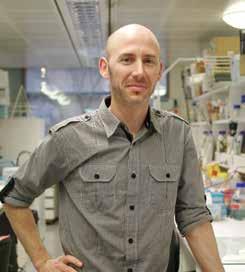
2 minute read
DR LUCY PALMER WITH
Your brain is a supercomputing powerhouse
Information about the environment constantly bombards us. Our brains need to process that data to make sense of it while responding appropriately. Much of this processing occurs in the somatosensory, auditory and visual cortices – found on the outer layer of our brains. Each brain cell in these cortical regions receives hundreds of thousands of inputs from different regions of the brain, which they integrate before passing on a coordinated output.
Decoding the language of the brain
Lucy's group uses state of the art tools to measure the brain's electrical and chemical signals – the language it uses to communicate. These tools include ultrafine glass needles to measure the voltage differences across cells, and chemical dyes that fluoresce in response to changes in calcium, a key chemical enabler of the electrical messages sent across a cell. Putting these measurements together is key to understanding what the cell is trying to tell you.
Dr Jason Howitt is working on an ambitious project: to use cancer drugs to treat a devastating form of autism.

He is concentrating on a form of autism associated with macrocephaly, which means “enlarged head”. Jason has removed a gene from mice that, in human genetic screens, is one of only a handful associated with autism and macrocephaly.
Much like children with autism, Jason’s mouse model appears normal at first. However, later in development things go awry resulting in the enlargement of the brain. This mimics a set of autistic patients being treated by paediatric neurologist Associate Professor Richard Leventer at Melbourne’s Royal Children’s Hospital.
Genetic sequencing of the children’s DNA revealed that the same gene Jason had removed from mice was also altered in the young patients at the Royal Children’s. A joint project is now underway to find one of the neurobiological causes that contribute to autism.
Encouragingly, the gene Jason is studying has been under intense scrutiny as part of unrelated cancer research. Extensive drug development means that FDA-approved drugs are ready to be pulled off the shelf to be tested in a mouse model. This has already resulted in encouraging findings, suggesting the potential for a new form of treatment for autism in the future.
When the language is garbled, signals lose meaning
We've all been tapped on the shoulder when we don’t expect it – resulting in a yelp or a little jump. The same tap when we can see our friend might just elicit a smile and nod. The very different outcomes depend on the various stimuli being integrated by the brain. Lucy is examining how signals from the prefrontal cortex (the brain's "executive office") are relayed to sensory cortical regions to alter their response – and our unique reaction to that tap on the shoulder.
Mental illness – communication breakdown
Certain neurones are responsible for making sense of information, busily decoding and interpreting before transmitting it on to other parts of the brain. Lucy's lab is taking big strides in understanding the fundamentals of how different brain regions communicate with one another. Working out how those communication channels are disrupted in illness or after brain injury will help us design cures and treatments.









